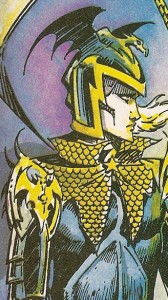 Something I have noticed as the years have gone by is the increasing number of time machines that seem to be available to me. Everywhere I look, I notice a song, book, scent or something that takes me back to a different time in my life, providing me both the feeling of older but also a nice moment of appreciation for times past.
Something I have noticed as the years have gone by is the increasing number of time machines that seem to be available to me. Everywhere I look, I notice a song, book, scent or something that takes me back to a different time in my life, providing me both the feeling of older but also a nice moment of appreciation for times past.
The other day, I was thinking long and hard about Pacific Comics’ retelling of Elric of Melniboné, the high fantasy stories from the 70s written by Michael Moorcock. I don’t know about you, but my high school evenings were pretty much dominated by the Moorcock’s tales of the Eternal Champion — I must have read both the Elric and Corum series 2-3 times before I moved on to different books!
For those you not familiar with the Albino Emperor-Sorcerer, suffice to say that this is a fantasy novel, with ancient races, gods, devils, demons, sorcery, and, of course, soul-eating swords. Elric is the classic doomed hero, always making difficult choices, always longing for a peace that he is fated to never to find.
In 1982 Pacific Comics enlisted the help of Roy Thomas, P. Craig Russell, and Michael T. Gilbert to adapt the first book in the series, Elric of Melniboné (first published in 1972), with the first issue coming out in the spring of 1983 — thirty freakin’ years ago!
Now, I had not even graduated from grammar school at this point, but somehow I was able to scrounge together $1.50 and get the first issue… and was, quite frankly, horrified at what I was looking at. The characters all looked so strange! These backgrounds and people…so…different! So…wrong!
In other words, this book turned my expectations of comic books inside out and upside down — this was not a superhero book, this had none of the familiar tones and trappings of a DC or Marvel comic…this was an adult comic, with gory battles, scantily clad women…I knew that this was something I was going to have to, well, figure out, despite the fact that I really wasn’t sure if I really even liked the book.
But I continued to buy the comic, getting 4 of the 6 issues in the mini-series. Over the years, I would return to the books once in awhile, I never got a chance to sit down and read of the books in the series all at once. Never, that is, until I went on eBay and bought the series a few weeks ago.
Revisiting these hard-to-come-by single issues was like sitting down with my 12 year old self and learning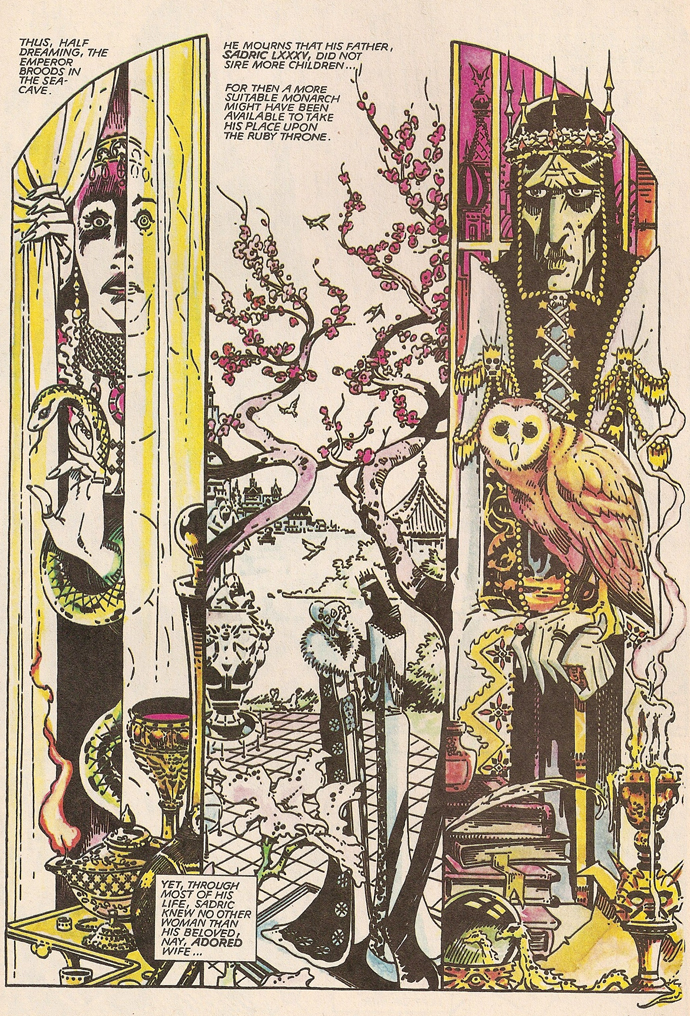 all about what made him tick. I found myself reading the comic as I did back in the day, lingering on each page, really soaking the art in—much easier to do when you don’t have a stack of comics waiting in the wings, by the way—and it dawned on me just how huge an influence these books made on my life. As a kid, even though I didn’t love the art, I recognized just how different it was—not hard to do, the stylized faces, outfits, the way the panels were framed, this book just looked and felt different than anything else on the shelves. What surprised me is how many of these elements have stuck with me in my own creative life. When I draw characters or write cards, many of the details that I add come directly from these books. There are expressions in these panels that I still use as a foundation for my drawings today—expressions that I found unusual at the time, but were done in a way that apparently helped define how I draw people today.
all about what made him tick. I found myself reading the comic as I did back in the day, lingering on each page, really soaking the art in—much easier to do when you don’t have a stack of comics waiting in the wings, by the way—and it dawned on me just how huge an influence these books made on my life. As a kid, even though I didn’t love the art, I recognized just how different it was—not hard to do, the stylized faces, outfits, the way the panels were framed, this book just looked and felt different than anything else on the shelves. What surprised me is how many of these elements have stuck with me in my own creative life. When I draw characters or write cards, many of the details that I add come directly from these books. There are expressions in these panels that I still use as a foundation for my drawings today—expressions that I found unusual at the time, but were done in a way that apparently helped define how I draw people today.
Founded in 1971 as a mail order retailer, Pacific Comics eventually turned into a distribution business after finding their newly formed retail stores could not keep their shelves stocked, a move that helped create the “Direct Market” form of distribution that comics has today—retailers buy issues at a discount, then resell the books to their customers. Their distribution business grew rapidly—between 1974 and 1980, the number of comic-book shops grew from 200-300 to around 1500, and Pacific’s warehouse in Southern California served 500 wholesale accounts, grossing almost a million dollars in 1980. Buoyed by their growing success, Pacific decided to get into publishing comics, working with Jack Kirby to introduce Captain Victory and the Galactic Rangers. Pacific Comics lured Kirby back into comics (he effectively quit in 1977) by promising him full ownership and copyrights — even promising to help with future licensing deals. The industry would see this kind of model appear again, specifically with Image Comics, sometime later.
Elric represented a fantastic collaboration between two fabulous artists, the aforementioned Russell and Gilbert and Roy Thomas. The artists would often switch inking and coloring duties—indeed, the covers re-order their names every issue—and Pacific Comics did their best to present the work in the best way they knew how. I say “did their best” because the run was plagued by printing errors and delays — I had a blast reading the introductions by Mike Friedrich, the title’s editor, which, for most issues, opened with an apology for one thing or another.
One thing that I remember about these comics when I first encountered them as a kid is that they felt and looked different than other books. With the benefit of hindsight, I realize that this was because Pacific was using better paper and higher quality ink — and using different printing and scanning technologies between issues. In fact, after the apologies, Friedrich would talk about the various new techniques being employed, like how they started using the “grey line” (aka “blue line”) method for issue 2, or, in issue 4 how started using a “laser scan” method to improve color fidelity, among others. In fact, as I look at this stack of six issues, I see not only the progression of Elric’s saga, but of key comic book technologies as well. The sixth issue does look significantly different than the first, with clearer lines, darker blacks and richer colors.
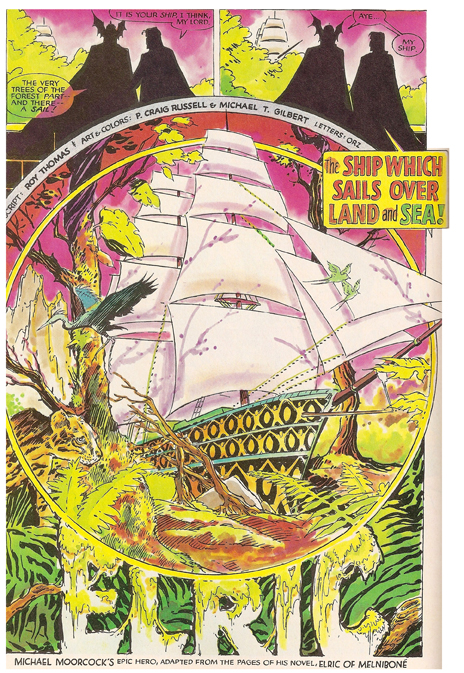 When I first thought about this article, I just thought it was going to be about finally finishing a series I began as a kid, but, after reading the creator notes, the editor’s page, and even the reader’s comments, I feel like I am looking at world of wonderful possibilities, a world that burned so bright…and then disappeared. You see, the last issue of Elric was published in April of 1984 — and Pacific Comics went into liquidation in September of that year. Elric was supposed to go on as a Pacific Comics book after “taking a much needed break for a few months.” Indeed, Michael T. Gilbert wrote a final note explaining that he was sad that P. Craig Russell was going to take a break for the first four issues of the planned sequel but be back for books 5 and 6 but they had some great things planned with the team at Pacific Comics…but it was not to be.
When I first thought about this article, I just thought it was going to be about finally finishing a series I began as a kid, but, after reading the creator notes, the editor’s page, and even the reader’s comments, I feel like I am looking at world of wonderful possibilities, a world that burned so bright…and then disappeared. You see, the last issue of Elric was published in April of 1984 — and Pacific Comics went into liquidation in September of that year. Elric was supposed to go on as a Pacific Comics book after “taking a much needed break for a few months.” Indeed, Michael T. Gilbert wrote a final note explaining that he was sad that P. Craig Russell was going to take a break for the first four issues of the planned sequel but be back for books 5 and 6 but they had some great things planned with the team at Pacific Comics…but it was not to be.
As I looked into the story, it turned out that First Comics (a great publisher who did Nexus, the English translations of Lone Wolf and Cub, American Flagg and others) snagged the rights for Elric — with Roy Thomas and Gilbert staying on as creators initially (their first issue of Elric: Sailer on the Seas of Fate was published in June of 1986)— and went on to adapt books 2-5 of the Elric six prose book series in the years that followed. Pacific Comics had done a great job of (re)introducing this character and his incredibly rich universe to comic book readers, presenting it on the best paper, using the best printing technologies of the era…and then, as its business fell apart, watch First Comics take the mantle.
People always talk about 1986 being one of the most important years in comics, and with the introduction Dark Knight Returns and Watchmen, you can see how this is a very easy case to make. However, I realize now that 1986 could not have happened without the efforts of publishers like Pacific Comics, First Comics, Eclipse Comics and other independents. Their success helped wake the bigger publishers up, encouraging them to embrace more adult adult themes and provide a better comic book experience, one that told compelling stories with art that was presented like art. I still own many, many comics from these intrepid publishers, and, honesty, I feel kind of cool to own so many books from this incredibly important time in comic book history; in fact, my dad is bringing down a few boxes this week—I have no doubt I will be doing my own version of Conor’s “back to the storage unit” in the months to come!
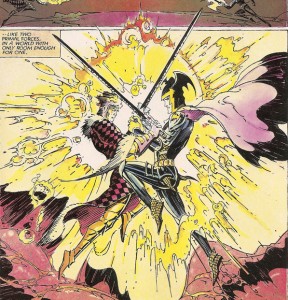
So, going back to read these “lost” issues of Elric was more than my just getting a chance to spend sometime with the 12-year-old me. It was a chance to watch the comic book industry change as the changes were happening. I could really sympathize with Mike Friedrich — he was so excited about this book and really wanted it to be successful, so he kept pushing the limits of his printing staff, to the point they were making really basic mistakes. You could just feel it in his writing, the stress he was under, tempered by the excitement he felt knowing that each issue represented the best comic book reading experience available.
As a modern reader, I am struck by the Elric books — they are still unlike any other book I am reading. Yes, the books feel dated; Roy Thomas felt the need to add narration to almost every single panel (it’s not enough to watch Elric walking in a panel, you need to get narration as to what he was thinking and where he was going, how hot the day was, etc), and some of the coloring looks like it was down with felt-tip markers and highlighter pens, but there are some truly wonderful full page layouts, with intricate lettering and finishing touches that one finds in more recent books by the same artists, including P. Craig Russell’s adaptation of Murder Mysteries, which I wrote about a few years ago. This is a wonderful aspect of comics, being able to go back in time and watch the early years of a creator’s career and see what tools and techniques “stuck,” serving him well in future projects.
“Yes, this is all well and good,” I can hear some of sighing, “but is Elric any good? Should I look for these issues on eBay, too?” Yes and yes. If you like P. Craig Russell, Michael Gilbert and Roy Thomas, these books are a must-find. The story of how Elric attains the runesword Stormbringer is engaging, the stakes are high, and the art is glorious. You can feel the respect and love the creators had for the Moorcock’s novels, and it is a joy to see the art just get better as the technologies learn to present it more effectively. This is an adaptation of 1970s epic fantasy — there are aging kingdoms at stake, malevolent gods are awoken, and epic battles are fought. I can’t think of any current book that tells this kind of story.
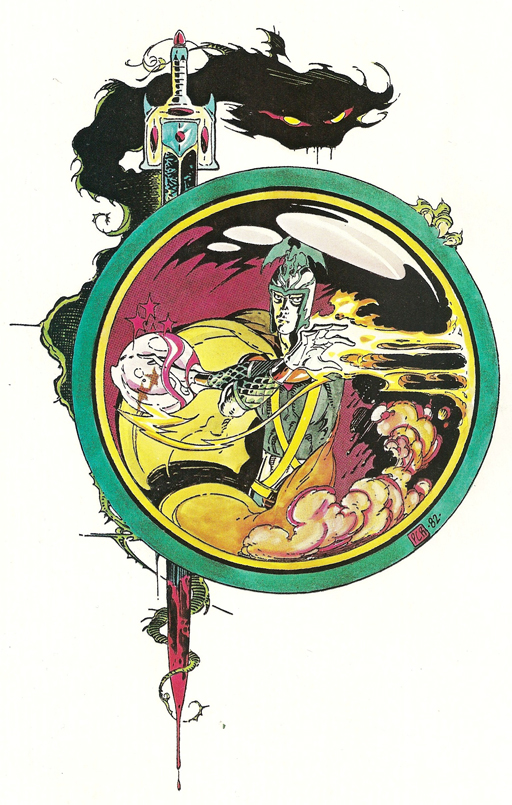 Of course, it would be a great deal easier if you could somehow just buy the trade on Amazon or something, but as far as I know, these books were never collected, which is a real shame (one does exist, for $170 of First Comics’ adaptation of Elric: Sailer on the Seas of Fate). As I leaf through the pages of these books, I see ads for other Pacific Comics titles, and it strikes me just how new these titles must felt to their readers, how exciting it was to see new kinds of stories coming from this scrappy publisher hell bent on making the best quality books in the market. It would be great to collect their books (complete with ads, editorials, letters pages, etc) to give readers a glimpse into the world of comics 20 years ago.
Of course, it would be a great deal easier if you could somehow just buy the trade on Amazon or something, but as far as I know, these books were never collected, which is a real shame (one does exist, for $170 of First Comics’ adaptation of Elric: Sailer on the Seas of Fate). As I leaf through the pages of these books, I see ads for other Pacific Comics titles, and it strikes me just how new these titles must felt to their readers, how exciting it was to see new kinds of stories coming from this scrappy publisher hell bent on making the best quality books in the market. It would be great to collect their books (complete with ads, editorials, letters pages, etc) to give readers a glimpse into the world of comics 20 years ago.
As I re-bag these books and stick them in my “Must Keep” short box, I realize that as easy it is to classify comics into different genres based on their publication (modern, Golden Age, etc), comic books are truly timeless. When they are at their best, comics are an ongoing conversation, with no end, just many beginnings. I get as much, if not more, from reading a series from decades ago as I do with modern comics. Modern comics provide me different stories and experiences, but one comic is not going to be more “valid” than the other—they are are all aspects of the same Eternal Comic-Book, to play on Moorcock’s turn of phrase. After spending the last year trying to understand my relationship with comics, I find it telling that my appreciation for them has been renewed, thanks to finishing a 20 year old series a younger version of myself once began.
Mike Romo is an actor in LA and is thinking about re-reading the Corum series by Michael Moorcock — the guy had this cool glove that was actually a demon and…. (email/twitter/facebook)


Awesome. I loved these books.
Hate to break it to you…but it was 30 years ago!
You didn’t read the title did you?
The title was edited.
ah
yeah–that was bit embarrassing.
I was a big fan of the Elric books when I was a kid, but never checked out the comics… or maybe I did. So long ago.
Actually, I’ll be honest… I think I liked a lot of the other Eternal Champion incarnations a lot more than Elric…
Fascinating. I’m a big Moorcock fan, though I’ve never gotten around to the Elric books.
They’re great. Elric is a fascinating character, and Moorcock seems to be clearly having a great time writing them.
Great article. Really brings back memories. I never read Elric but I was reading American Flagg, Nexus, E-Man, and Lone Wolf back then. Stuff that was probably more advanced than I was ready for. I also bought some of the magazine-size Elfquest comics and some of the Epic Comics titles. Dreadstar and Alien Legion were great. I still have all of those books. I’ve been thinking about digging them out for a read. The really crazy thing is that growing up in small town Georgia in the 80’s, there were 3 or 4 shops carrying these titles within an hour drive of one another. It was a different world for sure.
I saw a lot of myself in that wonderfully well written article!
I totally agree with your statement about this era influencing the climate that produced Watchmen and Dark Knight. It was the wild and wooly early days of the direct comic shops that opened the doors for creators and fans to try new stuff.
I see a lot of similarities between those years and the current digital age.
Thanks for the nice comment on the writing, Jim! Other than, you know, rudimentary math, it was fun…like how you tied that time of history with our current integration of digital books..
have a great weekend!
mike
Well, if you liked the Elric run, and you want to dive into Corum, you might want to track down The Chronicles of Corum, a 12 issue run from First Comics.
It was scripted by Mike Baron with pencils by Mike Mignola. It’s absolutely gorgeous. And, yeah, I’d really like to see some high quality reprints of a lot of the First Comics stuff.
Hi MickeyRossi-
Thanks for the tip. I am going to eBay immediately and will have to write another past-current review!
thanks for reading!
–mike
hey guys!
I really appreciate the comments. For some reason…I dunno, this piece…clearly it began WAY too long ago. I love the typo–Conor emailed me, “We had to change the title because it’s been 30 years, not 20… (sorry)”
I guess I am there.
Whatever–thanks for reading it. I actually have been thinking about writing it for a long time, but never thought to go on eBay. I am glad it piqued your interest — or re-awoken memories long since forgotten.
To be honest–it can be hard to encounter the comments, sometimes; you never know how things will go. But I am glad I checked in an appreciate you taking the time to write.
-mike
Pacific, Eclipse, First, Kitchen Sink, Fantagraphics, Slave Labor, Comico, all those independent publishers, even going back to Last Gasp, Rip Off Press and Apex Novelties, all made a huge contribution to the strong and feisty creator-owned, alternative, independent scene that exists today. Advances in paper, coloring, creator’s rights, content, ownership and freedom of expression can all be traced back to what was, in the early to mid-80’s, a truly heady time to be a comic book reader.
Thanks for the reminder, Mike. Celebrate Independence!
Mike, Great article!
I re-read this series every few years when I’m on a fantasy (comics) kick. It’s brillant and beautifully done. I’d love to see Roy Thomas try his hand at a fantasy novel.
If you are curious, Elric appeared in #14 of Marvel’s Conan The Barbarian from 1971. It’s created by Roy Thomas, Barry Windsor-Smith, and Sal Buscema. AS you can imagine, it’s fantastic. I picked it up recently from a comic book store while on holiday and read it twice in a row. I do not know if it has been collected, there may be some rights issues involved.
Cheers.